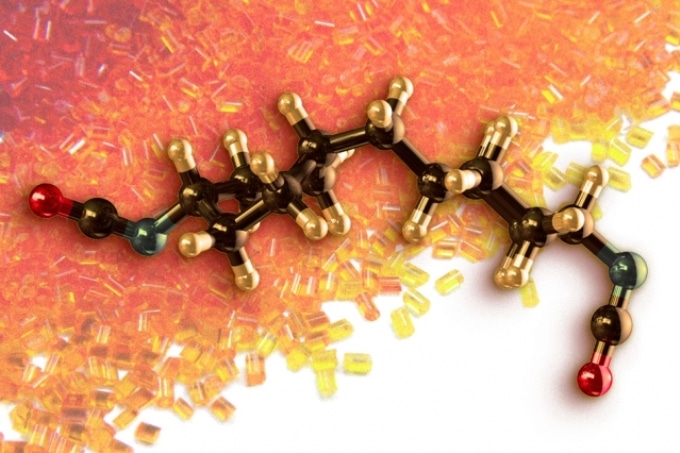Sep 16 2016
 Polymers, or long chains of repeating molecules, are found in many objects that we encounter every day, including anything made of plastic or rubber. In many materials, however, a significant fraction of these chains bind to themselves, forming defects. Image: Jose-Luis Olivares/MIT
Polymers, or long chains of repeating molecules, are found in many objects that we encounter every day, including anything made of plastic or rubber. In many materials, however, a significant fraction of these chains bind to themselves, forming defects. Image: Jose-Luis Olivares/MIT
Polymers are known to have a unique degree of elasticity - the extent to which they can stretch when a force is applied. For almost 100 years, the efforts made by polymer scientists to predict the elasticity of the polymers have been hindered as the materials generally have structural flaws at the molecular level, and these flaws impact elasticity in a number of unfamiliar ways.
Researchers from MIT have discovered a method to measure these structural flaws, and using this method they have demonstrated how the elasticity of polymer networks such as hydrogels can be accurately calculated.
This is the first time anyone has developed a predictive theory of elasticity in a polymer network, which is something that many have said over the years was impossible to do.
Jeremiah Johnson, Professor, MIT
This theory will help scientists to effortlessly design materials with a particular elasticity, which is currently more of a trial-and-error method.
Bradley Olsen, an associate professor of chemical engineering, and Johnson are the senior authors of the new study, which features in recent issue of the online edition of Science. The paper’s key authors are former MIT postdoc Mingjiang Zhong, postdoc Rui Wang, and graduate student Ken Kawamoto.
Counting Loops
Polymers, also known as lengthy chains of repeating molecules, are present in several objects that are used daily - including objects made of rubber or plastic. These chains develop networks where every single chain would perfectly bind with the other chain.
However, in real-life materials a major portion of these chains bind to themselves, resulting in the formation of defects - floppy loops that weaken the network.
With these loops it is also possible to carry out accurate calculations of the material’s elasticity, as the existing formulas for this calculation assume that the material has no flaws.
In 2012 Johnson and Olsen published a paper where they described a method to calculate these defects - the very first method that had ever been achieved. Polymer chains designed by the researchers were capable of integrating at a particular location a chemical bond that could be broken using hydrolysis.
After the polymers connect together to develop a gel, the researchers cut the bonds and calculate the quantity of varied types of degradation products. The researchers were able to determine the amount of polymer that formed loops by comparing that measurement with what would be seen in a defect-free material.
In a recent study, the researchers went ahead and explored that work by producing a method to establish how these defects impact the elasticity of the material. They first calculated how one individual defect can modify the elasticity. It is then possible to multiply this number by the total number of defects measured, which yields the total impact on elasticity.
We do one complicated calculation for each type of defect to calculate how it perturbs the structure of the network under deformation, and then we add up all of those to get an adjusted elasticity.
Bradley Olsen, Associate Professor, MIT
“Quantum Leap”
The researchers tested this approach on a number of materials and worked out a theory that permits them to predict the elasticity of a variety of polymer materials. This theory was found to be a lot more precise than the two existing approaches used to determine polymer elasticity - the phantom network model and affine network theory, Both these theories assume a defect-free, ideal network.
Sanat Kumar, a professor of chemical engineering at Columbia University, who was not involved in the research, states that this model should be used on all types of polymers.
They have taken an age-old problem and done very clear experiments and developed a very nice theory that moves the field up a whole quantum leap.
Sanat Kumar, Professor, Columbia University
The MIT team is currently working on applying this approach to other polymers. “I think within a few years you’ll see it broaden rapidly to cover more and more types of networks,” Olsen says.
The researchers also show interest in analyzing other features of polymers that influence their strength and elasticity, including a property called entanglement, which takes place when polymer chains are wound around each other, just like lights on a Christmas tree, without chemically binding to each other.
The research was financially supported by the Designing Materials to Revolutionize and Engineer our Future (DMREF) program of the National Science Foundation (NSF), as well as the U.S. Army Research Office through MIT’s Institute for Soldier Nanotechnologies and the Materials Research Science and Engineering Centers Program of the NSF.
Video Credit: Olsen Lab @ MIT/Youtube.com